Nordic men and women have a reputation for excelling in endurance sports in the international arena, and we train hard in our back garden too. Ever heard of the “Svensk Klassiker” (The Swedish Classic), a certificate awarded to those who finish four Swedish races in four different disciplines within a 12-month period? The races are “Vasaloppet” – a 90 km cross-country ski marathon held on the first Sunday of March; “Vätternrundan” – a 300 km bicycle ride around Lake Vättern in mid-June; “Vansbrosimningen” – a 3 km open-water swimming competition in Västerdalälven in July; and finally “Lidingöloppet” – a 30 km cross-country running race in September.
So, we know how to make the most of our outdoors. And we start very young!
Outdoor kindergartens, known as forest schools, where pre-school children spend their days in the forest, originated in Sweden in the 1950s and have since spread to other Nordic countries, Canada and even the UK. In a typical forest school, children as young as three are taken into the forest for several hours a day. They take no toys with them, but instead play with only what the forest provides. There is usually a primitive hut, tent or other indoor space for when the weather is really atrocious or the temperature falls below -10°C, but over the course of the year, most of the time is spent outdoors.
Activities include such simple fun as finding small animals or stomping in puddles. With high adult to child ratios, children can safely try out activities which are often considered too dangerous, such as climbing trees or lighting fires, and by dressing the children in good protective clothing, they are able to play freely, sitting and rummaging in the mud and bushes.
A 13-month Swedish study found that children attending forest schools are far happier, healthier and more socially adept than children in ordinary kindergartens. No doubt, they are also better prepared to take on the Svensk Klassiker later in life too! Not many of us at STP attended forest schools when we were young – or completed the Svensk Klassiker, for that matter – but when nature calls, don’t be surprised to find us lacing up our hiking boots and getting out there!



